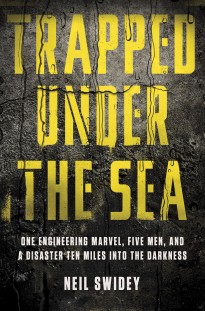An engineering marvel gone horribly wrong
A book review of “Trapped Under the Sea” by Neil Swidey
Share
 TRAPPED UNDER THE SEA: ONE ENGINEERING MARVEL, FIVE MEN, AND A DISASTER TEN MILES INTO THE DARKNESS
TRAPPED UNDER THE SEA: ONE ENGINEERING MARVEL, FIVE MEN, AND A DISASTER TEN MILES INTO THE DARKNESS
By Neil Swidey
They were the construction-site equivalent of special forces commandos, a team of deep-sea divers who earned a living squeezing into tight, dark spaces that would make most mortals hyperventilate. On a fateful morning—July 21, 1999—their mission was to venture into the loneliest possible hole: a long, narrow tunnel that stretched nearly 16 km under Boston Harbor. Five men went down. Only three made it out.
What happened to Billy Juse and Tim Nordeen was a tragedy with many triggers, set in motion by Boston’s ambitious, multi-billion-dollar effort to clean up its notoriously polluted wharf. (The city had been dumping raw sewage into the sea for so long that locals had a nickname for all the floating tampon applicators: “beach whistles.”) By the late 1990s, a state-of-the-art sewage treatment project was nearly complete, except for a few dozen cork-like plugs that needed to be removed from the farthest regions of the tunnel. How to reach those pesky plugs (in a straw-like shaft with no light, no oxygen and no exit) was the mystery question nobody could answer. After months of meetings and memos, the contractor called in the elite divers—and entrusted a Canadian engineer, Harald Grob, to make sure they stayed alive.
Based on hundreds of interviews and every available document, Swidey’s narrative paints a disturbing portrait of big-ticket construction projects, and how safety can be so easily discarded in the pursuit of deadlines and profit. But it’s Grob, the “controlling Canadian,” who is cast as the primary villain. Now working in British Columbia, Grob’s job was to find a reliable air supply for the divers. His makeshift solution—an unproven device that mixed liquid oxygen and nitrogen, which was fed to the men through hundreds of metres of twisted hose—was, in Swidey’s words, “an eighth-grade science-fair project gone horribly wrong.” The device wasn’t even meant for people; it was designed to vacuum-pack supermarket burritos.
Though a complex and technical tale, Swidey’s book is, at its core, a story about people: the people who risked their lives. The people who loved them. And the people who should have seen the disaster to come.
Michael Friscolanti